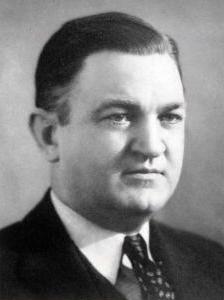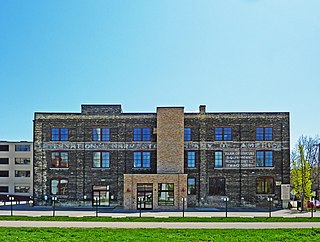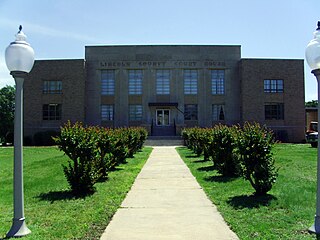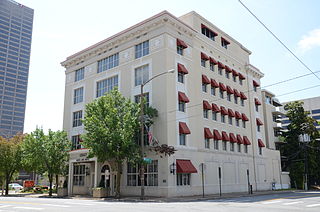
Carl Edward Bailey was an American attorney and the 31st governor of Arkansas from 1937 to 1941.

Petit Jean State Park is a 3,471-acre (1,405 ha) park in Conway County, Arkansas managed by the Arkansas Department of Parks and Tourism. It is located atop Petit Jean Mountain adjacent to the Arkansas River in the area between the Ouachita Mountains and Ozark Plateaus.

The Cyrus McCormick Farm and Workshop is on the family farm of inventor Cyrus Hall McCormick known as Walnut Grove. Cyrus Hall McCormick improved and patented the mechanical reaper, which eventually led to the creation of the combine harvester.

Hillcrest Historic District is an historic neighborhood in Little Rock, Arkansas that was listed on the National Register of Historic Places on December 18, 1990. It is often referred to as Hillcrest by the people who live there, although the district's boundaries actually encompass several neighborhood additions that were once part of the incorporated town of Pulaski Heights. The town of Pulaski Heights was annexed to the city of Little Rock in 1916. The Hillcrest Residents Association uses the tagline "Heart of Little Rock" because the area is located almost directly in the center of the city and was the first street car suburb in Little Rock and among the first of neighborhoods in Arkansas.

Butchie's Drive-In, now known as Bailey's Dairy Treat, is a historic restaurant at 534 Park Avenue in Hot Springs, Arkansas. It is a small single-story Art Moderne structure, with sleek rounded lines, neon lighting, and a stucco finish. There are two service windows at the front, and the interior has retained much of its original form, even though the kitchen equipment has been upgraded. The floor is largely original quarry tile, and the bathroom has original fixtures. Built in 1952, this is one of the few establishments of this type to survive, of a number that once lined Park Avenue.
The University of Arkansas Campus Historic District is a historic district that was listed on the National Register of Historic Places on September 23, 2009. The district covers the historic core of the University of Arkansas campus, including 25 buildings.

The International Harvester Company Warehouse is a building in southeast Portland, Oregon listed on the National Register of Historic Places.

The McCormick–International Harvester Company Branch House was built in 1898 in Madison, Wisconsin as a distribution center for farm implements of the McCormick Harvesting Machine Company. After McCormick merged into the International Harvester Company in 1902, the building was expanded and served the same function for the new company. In 2010 it was added to the National Register of Historic Places.

The First United Methodist Church is a historic church building at 204 S. Main in Hamburg, Arkansas. The brick Gothic Revival building was built in 1910 for Hamburg's first organized congregation, founded in 1850, which had previously met in a wood-frame building on the same site. It was designed by the Nolley Brothers, who owned a local brickyard, and was based on Gothic Revival designs that one of them had observed at the St. Louis World's Fair.

The Parnell-Sharpe House is a historic house at 302 North 2nd Street in McGehee, Arkansas. The 1+1⁄2-story brick house was built in 1936, and is probably unique in Desha County as an example of French Eclectic architecture constructed using local materials. The house is built out of red tapestry brick, and has a roughly T-shaped plan, with a projecting element in the front (west) facade that includes a tower topped by a conical roof. To the north is a single-story section that was originally a garage, but has been converted to interior space.

The county courthouse of Lincoln County, Arkansas is located at 300 South Drew Street in Star City, the county seat. The two story building was designed by Wittenberg & Delony of Little Rock and built in 1943. It is predominantly buff-colored brick, with limestone trim, and has a flat roof that is hidden by a parapet. The building's front, or western, elevation, has a central projecting section that is slightly taller than the wing sections, and is faced primarily in limestone. Four triangular stepped limestone pilasters frame the elements of this section, including the main entrance in the central bay, which now has replacement doors of aluminum and glass. Above the pilasters is a limestone panel identifying the building as the "Lincoln County Courthouse" in Art Deco lettering. It is believed to be the only Art Deco building in the county.

The Craighead County Courthouse is located at 511 Main Street, in the center of Jonesboro, Arkansas, the county seat of Craighead County. It is a two-story brick structure with limestone trim, built in 1934, and is the city's only significant example of Art Deco architecture. The building has a stepped appearance, with a large central block that has an oversized second story, and is flanked by smaller two-story wings, from which single-story sections project to the front and back. Vertical panels of fluted limestone accentuate corner projections from the main block, a motif repeated near the roof line of that block. The main entrance is recessed in an opening flanked by similarly fluted panels. The courthouse is the fifth of the county to stand on the site. Near the entrance to the courthouse stands a copy of John Paulding's World War I memorial, Over the Top, placed in 1920, and often confused with E. M. Viquesney's "Spirit of the American Doughboy".

The Hotel Fredeirica is a historic commercial building at 625 West Capitol Avenue in Little Rock, Arkansas. The five-story building was built in 1914 and enlarged in 1941. The original building was designed by Theodore M. Sanders, and the addition by Edward Durell Stone, both prominent Arkansas architects. Both sections of the building are excellent representatives of their architectural styles: the older in a typical early 20th-century commercial style, and the addition in the International style.

The Carl and Esther Lee House is a historic house at 17493 United States Route 65 West in Damascus, Arkansas. It is a 1+1⁄2-story wood-frame structure, with a stone veneer exterior and cream-colored brick trim. The front facade has projecting gable sections, with a porch sheltered by one such section with curved-arch openings. The larger gables have sunburst brick designs near their peaks. The house was built about 1948; the exterior stonework was done by Silas Owens, Sr., a regionally prominent stonemason. The house exhibits many of Owens's hallmarks, including the use of cream-colored brick, herringbone-patterned stonework, and arched openings.

The Pioneer Implement Company, also known as the International Harvester Transfer House, is a historic building located in Council Bluffs, Iowa, United States. Eli Shugart, Ferdinand Weis and F.R. Davis formed Pioneer Implement Company in 1893, and they built the four-story Late Victorian section of the building the same year. This was during a period of growth in the city's "Implement District," which is located to the south of the central business district. What made this company standout from the others in the district is that it was locally owned and operated agricultural implement business, rather than one owned by a factory from the east. The company went out of business in 1915 and the building was taken over by International Harvester, which owned the building next door. They added the single-story brick addition to the south in 1927. When IH closed their Council Bluffs operation in 1964 they were the only farm implement that was still in business in the Implement District. The building was occupied by various businesses after that, including United Parcel Service. Artspace, Inc. acquired the building and converted it into live/work spaces for artists. The building was listed on the National Register of Historic Places in 2008.

The McCormick Harvesting Machine Company Building, also known as the International Harvester Transfer House is an historic building located in Council Bluffs, Iowa, United States. The first railroad arrived in the city in 1867, and by 1898 there were 11 truck line railroads that terminated here. That made Council Bluffs an excellent place for the transfer and distribution of goods. Chicago based McCormick Harvesting Machine Company had this four-story brick structure built in 1894 as one of their branch houses. Those facilities acted as a dealership for the company's products. In the 1902 McCormick and four other companies merged to form International Harvester (IH). By 1922, this building became one of IH's four domestic transfer house facilities. Those facilities received large stocks of the company's products by train and distributed them to the branch houses. IH continued to use this building until 1964. It was listed on the National Register of Historic Places in 2012.
The Ellis Building is a historic commercial building at 208 North Block Avenue in Fayetteville, Arkansas. It is a single-story brick building, with a hip roof that has a rounded top section. The roof's shape is obscured from the front by a low stepped parapet. The front facade has a former garage bay opening to the left, and a pair of plate glass display windows flanking a pedestrian entrance to the right. The building was under construction about 1923, and is one of the oldest surviving automotive service buildings in northwestern Arkansas. It has housed a variety of commercial businesses since ending automotive use about 1955.

The Carpenter Building is a historic commercial building at 136 East Main Street in Gentry, Arkansas. Built in 1927–29, it is a single-story masonry structure, its exterior finished mainly in red brick and hollow clay tile. A stepped parapet obscures the flat roof, and the front facade is inset with square pier supports, giving the impression of a portico. The interior includes surviving original sections of tin ceilings. The building originally housed a retail grocery, as well as a mortuary and funeral chapel, but has since been repurposed to other uses.
The Magnolia Petroleum Company Filling Station is a historic automotive service station building at Larch and 1st Streets in Kingsland, Arkansas. It is a small single-story masonry building, built of red and buff brick and covered by a gabled roof. The front facade has a door on the left side and a plate glass window on the right. A concrete pad in front of the building originally supported the fuel pumps. The building was built about 1930, and is a good example of an early filling station with Tudor and Craftsman features, built to a Magnolia Company design which was used for at least one other filling station, in North Little Rock.
The International Harvester Showroom and Warehouse is a historic building at 6-12 North River Street in Aurora, Illinois. The building served as a dealership for farming equipment company International Harvester, which was headquartered nearby in Chicago, in the early twentieth century. While the building's construction date is unclear, it was built before 1901, and International Harvester first occupied it in 1905. The building was one of 99 independently run International Harvester dealerships in the United States and Canada in the 1900s, and in 1905 it was among the company's top ten dealers in sales. The building is technically made up of two conjoined buildings with mirrored floor plans; each building has a cast iron store front, and their open floor plans and tall floors were ideal for holding large equipment. In 1912, International Harvester relocated their dealership to a larger building at 251 South River Street.


















